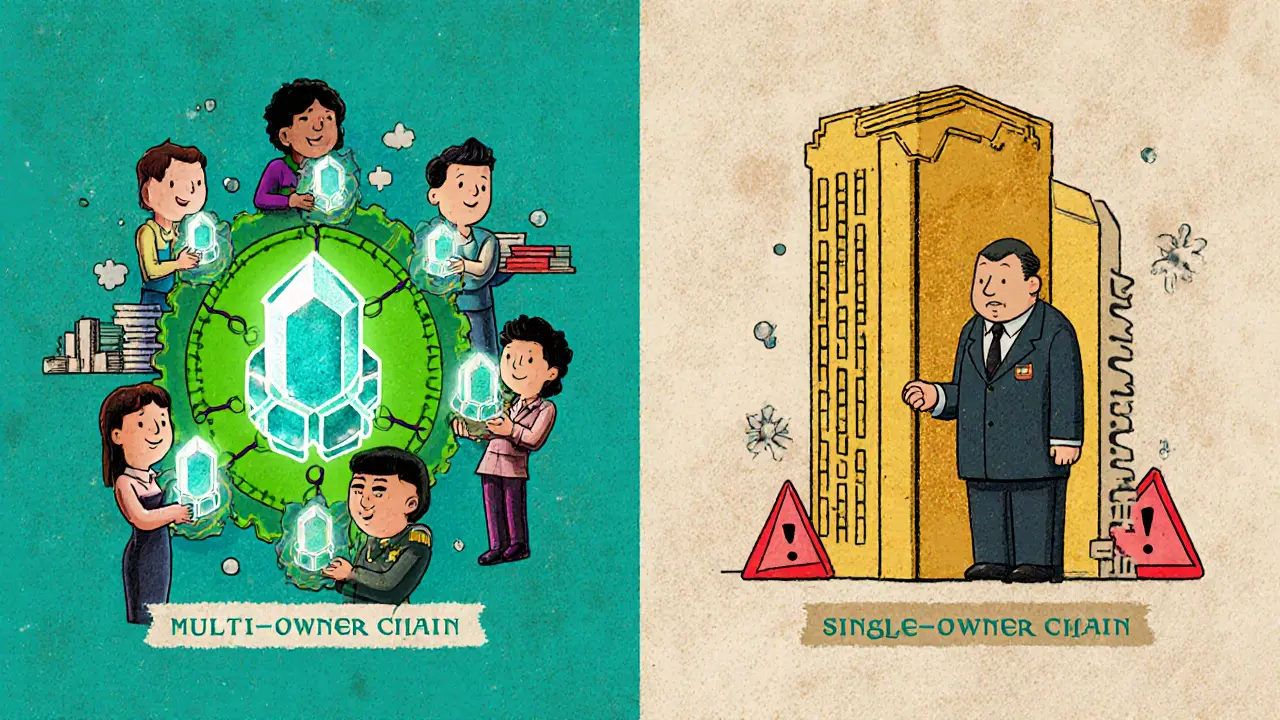Blockchain Voting Architecture Explorer
This interactive tool helps you understand the two main blockchain voting architectures and their trade-offs.
Decentralized High Resilience Peer Validation
Distributed among several independent organizations with collective trust model.
Best for: Public elections requiring transparency and resilience.
Centralized Single Point of Failure Easy Legal Alignment
Managed by one election authority or vendor with centralized trust model.
Best for: Government pilots and controlled environments.
| Feature | Multi-owner Chain | Single-owner Chain |
|---|---|---|
| Control | Distributed among several independent organizations | Managed by one election authority or vendor |
| Trust Model | Collective trust; peers validate each other’s blocks | Centralized trust; reliance on a single entity’s integrity |
| Resilience | Higher fault tolerance; failure of one node doesn't halt voting | Potential single point of failure if the owner’s infrastructure is attacked |
| Regulatory Fit | Complex to align with existing election laws that expect a single authority | Easier to map to current legal frameworks |
| Examples | Consortiums of NGOs, universities, and NGOs running a public ballot | Government-run pilots where the state hosts all nodes |
Once a vote is on the chain, it cannot be erased or altered without detection.
The entire voting history is publicly readable, allowing third-party audits without compromising voter privacy.
Smart contracts can compute results in real time, eliminating days-long manual tabulation.
Voters with internet access can participate from remote locations.
Eliminates paper ballots and centralized counting centers reducing logistical expenses.
An adversary can flood the network with bogus transactions, overwhelming nodes.
Voter devices and the registration portal are classic attack surfaces.
Losing a private key means losing the ability to vote; mishandling keys could expose voter choices.
If a subset of nodes is cut off, conflicting forks could appear, creating ambiguity.
Imagine casting your vote from a smartphone, watching it lock into a ledger that can’t be altered, and seeing the final tally in seconds. That vision is what blockchain voting promises, but the path from hype to reliable practice is littered with technical, security, and social hurdles. This article breaks down the core concepts, walks through the tech stack, weighs the upside against the downside, and shows where pilots are currently testing the idea.
Key Takeaways
- Blockchain voting records each vote on a distributed ledger, making tampering theoretically impossible.
- Smart contracts can automate counting, but they only secure the ledger, not the entire voting ecosystem.
- Two main architectures exist: multi‑owner chains (decentralized peers) and single‑owner chains (central control).
- Security experts warn that denial‑of‑service attacks and weak voter‑side authentication remain critical flaws.
- Most real‑world deployments are limited to boardrooms, private associations, or small‑scale pilots.
What Is Blockchain Voting?
When we talk about blockchain voting is a decentralized electronic voting system that stores each ballot on a distributed ledger, we’re extending the same principles that cryptocurrency uses to record monetary transactions. Instead of sending coins, the system records a cryptographic hash of a voter’s choice, a timestamp, and a unique vote identifier. Because every new block references the hash of the previous block, the chain becomes immutable-altering a single vote would require rewriting every subsequent block on every participating node.
How the Technology Works
The end‑to‑end flow looks a lot like a traditional e‑voting app, but with a few blockchain‑specific steps:
- Voter registration: Users download a dedicated app, prove citizenship (often via government ID APIs), and generate a public‑private key pair.
- Ballot token issuance: The election authority mints a digital token, assigns it to the voter’s public key, and deposits it into the voter’s encrypted wallet.
- Vote casting: The voter selects an option; the app signs the choice with the private key, producing a transaction that includes the vote hash and timestamp.
- Block formation: A network of nodes aggregates signed votes into a block, runs a consensus algorithm (usually Proof‑of‑Authority or Practical Byzantine Fault Tolerance for permissioned systems), and links the block to the chain.
- Smart contract tally: A pre‑deployed smart contract automatically counts votes as they are recorded, updating a public tally that anyone can verify.
The result is a transparent ledger where anyone can audit the total count, but individual ballots remain anonymous because only the hash-not the voter’s identity-is stored.
Potential Benefits
Proponents point to several advantages that could reshape democratic processes:
- Immutability: Once a vote is on the chain, it cannot be erased or altered without detection.
- Transparency: The entire voting history is publicly readable, allowing third‑party audits without compromising voter privacy.
- Speed: Smart contracts can compute results in real time, eliminating days‑long manual tabulation.
- Accessibility: Voters with internet access can participate from remote locations, potentially boosting turnout among expatriates and people with disabilities.
- Cost efficiency: Eliminating paper ballots and centralized counting centers reduces logistical expenses for large jurisdictions.
Think of the Brookings Institution’s assessment, which frames these gains as a way to “combat voter fraud, boost turnout, maintain transparency, and reduce costs.”

Major Security Concerns
While the ledger itself is robust, the surrounding ecosystem is far from bulletproof:
- Denial‑of‑Service (DoS) attacks: An adversary can flood the network with bogus transactions, overwhelming nodes and preventing legitimate votes from being recorded.
- Endpoint vulnerability: Voter devices and the registration portal are classic attack surfaces. Malware could steal private keys or alter votes before they hit the blockchain.
- Key management: Losing a private key means losing the ability to vote; mishandling keys could expose voter choices.
- Network partitioning: If a subset of nodes is cut off, conflicting forks could appear, creating ambiguity about which votes are valid.
- Regulatory uncertainty: Many jurisdictions lack clear legal frameworks for blockchain‑based elections, raising questions about legitimacy and auditability.
David Jefferson of the U.S. Vote Foundation stresses that “most serious vulnerabilities threaten the integrity and secrecy of voting before ballots ever reach the blockchain.” MIT’s Digital Currency Initiative echoes this, warning that nation‑scale failures could become undetectable.
Architectural Models
Two primary deployment styles dominate the conversation:
| Feature | Multi‑owner Chain | Single‑owner Chain |
|---|---|---|
| Control | Distributed among several independent organizations | Managed by one election authority or vendor |
| Trust Model | Collective trust; peers validate each other’s blocks | Centralized trust; reliance on a single entity’s integrity |
| Resilience | Higher fault tolerance; failure of one node doesn’t halt voting | Potential single point of failure if the owner’s infrastructure is attacked |
| Regulatory Fit | Complex to align with existing election laws that expect a single authority | Easier to map to current legal frameworks |
| Examples | Consortiums of NGOs, universities, and NGOs running a public ballot | Government‑run pilots where the state hosts all nodes |
Both designs aim to keep the ledger tamper‑proof, but the multi‑owner model distributes power, while the single‑owner model mirrors today’s centralized election administration.
Real‑World Pilots and Use Cases
So far, large‑scale national elections have not adopted blockchain voting, but several niche projects have shown what’s possible:
- West Virginia’s mobile voting test (2018): Used a smartphone app for overseas military personnel; the backend was not blockchain‑based but sparked interest in immutable records.
- Estonia’s e‑Residency voting experiments: While still using conventional cryptographic signatures, the country’s digital ID infrastructure informs future blockchain integrations.
- BELEM framework: An open‑source suite that deploys smart contracts to count votes from electronic voting machines, demonstrating a bridge between legacy hardware and blockchain back‑ends.
- Corporate board elections: Companies like Siemens and the United Nations have run shareholder votes on permissioned blockchains, citing speed and auditability.
These pilots generally stay within controlled environments where participants have technical support, limiting exposure to the broader security issues that affect public elections.
Practical Challenges & Adoption Hurdles
Beyond technical security, several non‑technical factors slow adoption:
- Digital literacy: Voters need to understand key management, wallets, and app navigation, which can be a barrier for older or less‑tech‑savvy citizens.
- Infrastructure reliability: Elections demand 100% uptime. Maintaining a distributed network across an entire country during a single day is unprecedented.
- Legal compliance: Many countries require a paper trail for audits. Integrating an immutable digital ledger with paper‑based recounts is an open problem.
- Public trust: Citizens may distrust a “black‑box” system they cannot see, especially after high‑profile cyber attacks on election infrastructure.
- Cost of node operation: Running and securing multiple full nodes adds operational expense, potentially offsetting paper‑ballot savings.
Researchers from the University of Minnesota Morris argue that, for now, hand‑marked paper ballots remain the most secure method, though blockchain could complement them in emergencies.
Future Outlook
Will blockchain voting ever replace the paper ballot? The consensus among election‑security experts is cautious optimism. Advances needed include:
- Robust, user‑friendly key management solutions (e.g., hardware security modules or biometrics).
- Hybrid architectures that combine a paper audit trail with a blockchain ledger for real‑time verification.
- International standards that define how blockchain records satisfy legal requirements for transparency and recountability.
- Improved DoS mitigation strategies, such as layer‑2 scaling solutions that absorb traffic spikes.
If these hurdles are cleared, we may first see blockchain voting in low‑stakes settings-local council elections, university student bodies, or corporate governance-before tackling national ballots.

Frequently Asked Questions
Is a blockchain vote truly anonymous?
Yes, the ledger stores only a cryptographic hash of the vote linked to a public key. The key cannot be traced back to a personal identity without the private key, which remains on the voter’s device.
Can blockchain prevent all types of election fraud?
No. While the ledger blocks tampering after a vote is recorded, fraud can still happen earlier-through phishing, malware, or compromised registration systems.
What is the difference between a public and a permissioned blockchain for voting?
Public blockchains allow anyone to join the network, which raises scalability and privacy concerns. Permissioned blockchains restrict participation to vetted entities (e.g., election officials), offering better performance and control.
How do smart contracts count votes?
A smart contract receives each signed vote transaction, validates the voter’s eligibility, increments a counter for the chosen option, and updates a publicly readable tally. The contract’s code is immutable once deployed, ensuring the counting logic cannot be altered mid‑election.
Are there any countries that have fully adopted blockchain voting?
Not yet. Most experiments remain pilots or limited to private organizations. National governments continue to view blockchain voting as experimental due to unresolved security and legal issues.


Enya Van der most
June 30, 2025 AT 04:33Blockchain voting lights up the democratic stage like fireworks over a midnight sky. Imagine each ballot swirling into a digital tapestry that no hand can tear apart. The immutability of the ledger turns every vote into a stone engraved in history. Transparency shines through as anyone can glance at the chain without seeing the voter’s face. Speed rockets forward, turning days‑long tabulations into instantaneous tallies. Accessibility spreads its arms, letting citizens in remote islands or cramped apartments cast their say with a tap. Cost efficiency slashes the mountain of paper, ink, and courier fees that drain public budgets. Multi‑owner chains distribute power, letting NGOs, universities, and civic groups guard the process together. Single‑owner chains keep things simple for governments that need a clear legal line of responsibility. Security gains a new armor as tampering would require rewriting every block on every node. Yet the surrounding ecosystem-devices, key management, registration portals-remains the soft underbelly that attackers love. Denial‑of‑service waves can still flood the network, drowning genuine votes in noise. Educating voters on private keys and wallets becomes the new civic duty, a digital rite of passage. Pilot projects in boardrooms, universities, and tiny municipalities prove the concept can work at scale. If we master these challenges, the promise of a transparent, swift, and inclusive election could finally become reality.
Latoya Jackman
July 2, 2025 AT 21:10The article correctly outlines the trade‑offs between multi‑owner and single‑owner blockchain voting architectures.
Megan King
July 5, 2025 AT 13:47Wow, this stuff is mind‑blowing! I love how the piece breaks down the benefits-immutability, transparency, speed-like a recipe for a better democracy. But hey, we gotta remember the real‑world hurdles, like folks actually learning to handle private keys without breaking a sweat. Those pilot programs? Super cool, especially the boardroom votes where everyone can see the results instantly. Still, I think we need more hands‑on guides for everyday voters; otherwise, the tech stays stuck in the lab. Also, the security concerns are no joke-malware on phones could mess things up big time. All in all, it's a promising direction, but we gotta keep it real and user‑friendly. Keep the updates coming, folks!
C Brown
July 8, 2025 AT 06:24Oh great, another tech hype train promising to fix elections with a few lines of code while ignoring the messy human side of voting.
Noel Lees
July 10, 2025 AT 23:01Not so fast, buddy. The real power of blockchain lies in its decentralization, which actually mitigates the single‑point‑of‑failure worry you’re whining about. 🛡️💪
Adeoye Emmanuel
July 13, 2025 AT 15:37From a philosophical standpoint, the shift to a distributed ledger challenges the very notion of trust, moving it from institutions to cryptographic guarantees. This transition demands a reevaluation of civic responsibility, as voters become custodians of their own keys. The ethical implications are profound, urging us to balance transparency with privacy.
Raphael Tomasetti
July 16, 2025 AT 08:14In practice, permissioned ledgers provide the needed throughput for national scales while preserving auditability.
Jenny Simpson
July 19, 2025 AT 00:51Sure, blockchain is the silver bullet for every problem-just like magic beans solving all hunger.
Sabrina Qureshi
July 21, 2025 AT 17:28Whoa!!! This is exactly what I was thinking!!! Blockchain will solve EVERYTHING!!! No more fraud!!! No more delays!!!
Rahul Dixit
July 24, 2025 AT 10:05Don't be fooled by the hype; the same shadowy groups that rig conventional polls will infiltrate blockchain systems, planting backdoors and siphoning votes under the guise of "security upgrades".
CJ Williams
July 27, 2025 AT 02:42Yo! The truth is out there!!💥 But c0nsider th@t the real risk is the people who dont kn0w how to keep th3ir keys safe!!! Hey, we need more edu!! 😅
mukund gakhreja
July 29, 2025 AT 19:19Interesting points, but the reality is far less dramatic – most attacks target the front‑end, not the chain itself.
Michael Ross
August 1, 2025 AT 11:56Agreed, focusing on front‑end security is essential for a robust voting system.
Deepak Chauhan
August 4, 2025 AT 04:33Indeed, a balanced approach is required.